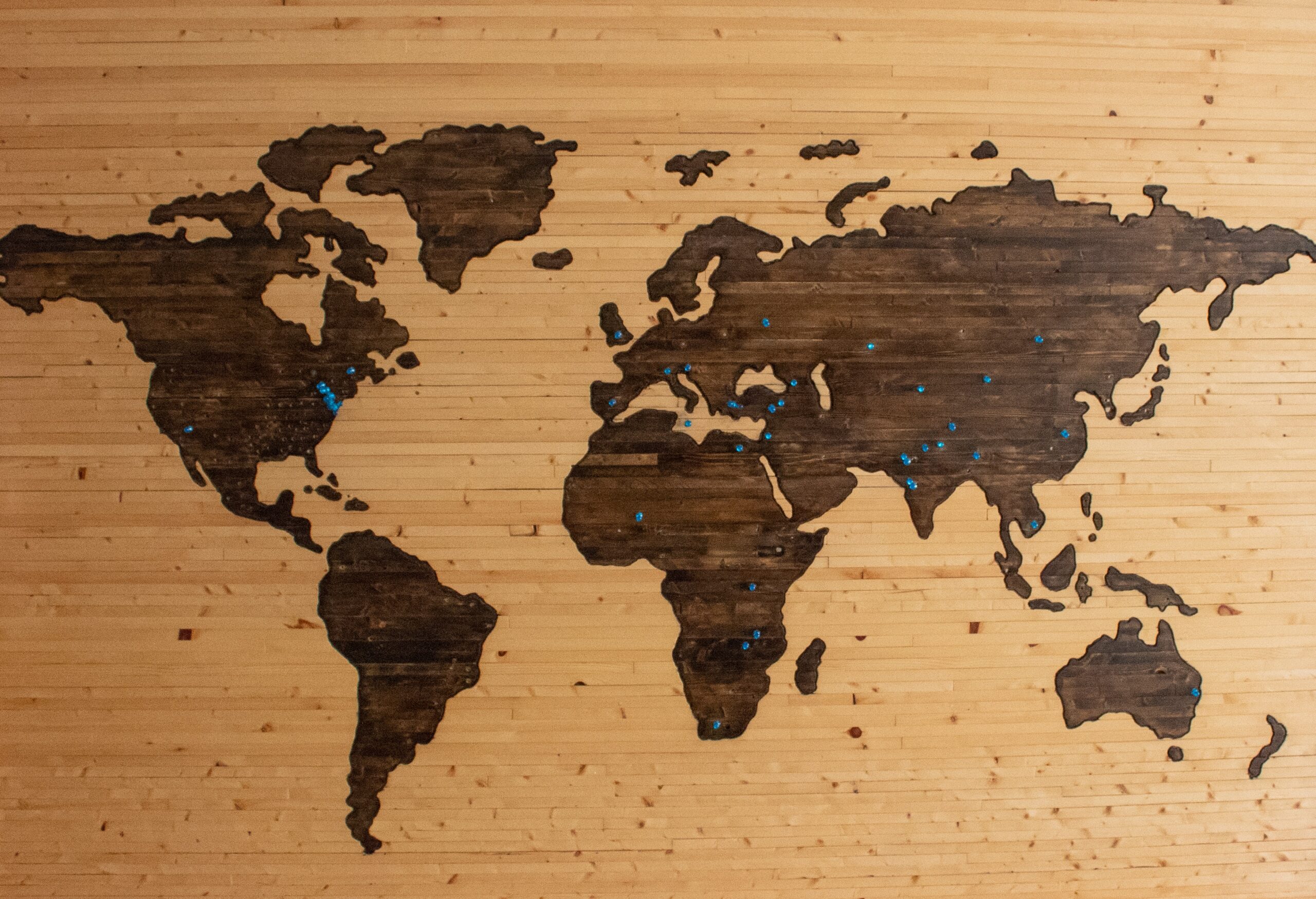
Photo from Instant Images
Peter Now, this week, we’re taking a look back at some of the top podcast episodes that we broadcast in 2021. You can hear the full episodes by checking out our website Action Packed Travel, but here’s a taste of each of them.
Dan Egan: Extreme Skiing Pioneer
Last winter, we met up with us extreme skiing pioneer Dan Egan. For the past 30 years, Dan, along with his brother John, has been jumping off cliffs and making stomach- churning first ascents of quite impossibly steep mountains all over the world. He’s still alive to tell his tales, and he’s finally got around to recording them in his new book 30 Years in a White Haze. They include some remarkable near-death experiences he told us about his experience on Mount Everest, the highest peak in Europe.
Dan It’s one of the seven summits of the world. And oddly enough, Elbrus kills more people than Everest. On our trip, and back in 1990, that truly was the case – we lost over 30 climbers. There were 50 people trapped in the storm and I was among those trapped. We were trapped somewhere around 17,000 feet and I was 38 hours without food or water.
Felice And how did you survive?
Dan Well, I was with three other climbers from my expedition and we had joined up with a group of Russians and we had dug snow caves for the night. But the snow caves are really spread out and it was 100mph winds, snowed five feet that night. My two fellow climbers went to another snow cave and never told me, so I was abandoned in my cave. And one of the Russians must have taken a head count because he went out in the storm and found my cave, and in the middle of the night came into the cave and I believe saved my life. He huddled with me, warmed me back up, I was having visions, I had seen the bright light. And Sasha said to me, ‘Tonight, we sleep like brothers,’ and we survived the night.
Peter That was quite a life changing experience for you?
Dan It was in a lot of ways. I was young but my brother didn’t want to summit that day and I did. So he was down below. He had rescued other climbers off the mountain during the storm, but from a lower spot. And like I said, I saw the bright lights and it had a major effect on me. The next day, Sasha and I rescued 14 people ourselves and eventually got down off the mountain. But the whole ordeal took 38 hours.
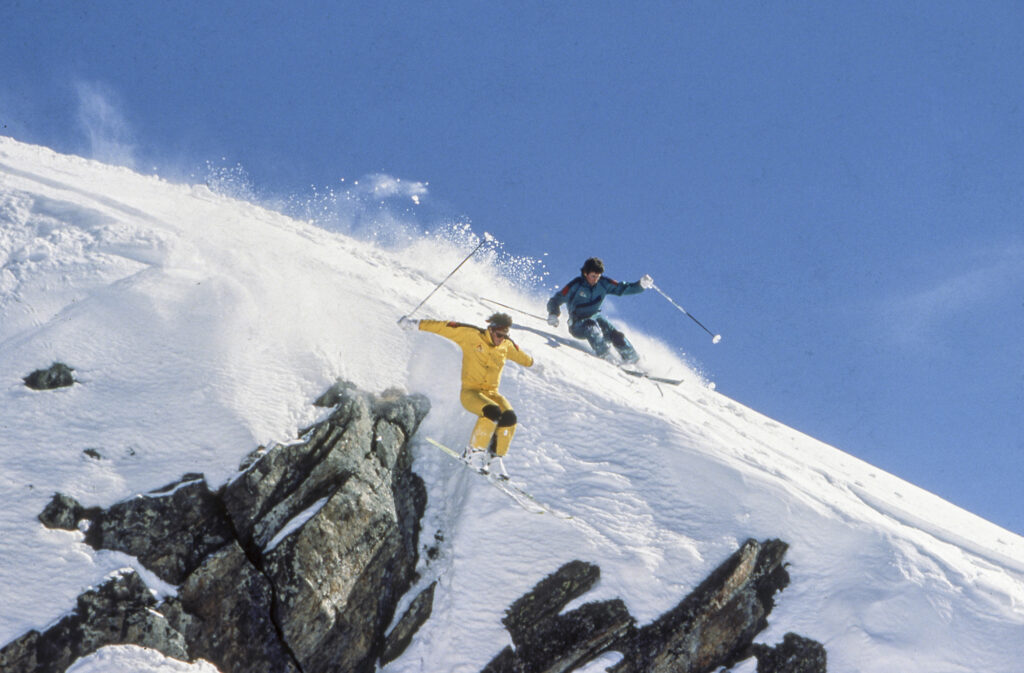
Dan launching off the cornice with John
<<<<>>>>
Matilda Temperly, Action Woman Behind The Lens
Felice Springtime found Action Packed Travel’s Louise Hall on a cider farm in Somerset. Talking to top fashion photographer and worldwide adventurer Matilda. Temperley. Tilly started out as a scientist researching disease control on the Sudanese Ugandan border in East Africa, but she was soon wondering if this is what she really wanted to do.
Matilda I’d got to a stage where I thought it wasn’t for me. I didn’t want to do this for life, and I was wondering what it really was that I did want to do. And I was racking my brains and I was thinking, ‘What have I enjoyed in life? OK, this is not going to be my life, so what is it that I can do?’ And I couldn’t really remember what my ambitions were when I was young.
When I was really young, I wanted to be a photographer and a trapeze artist, and so it was a time when I was realising the power of photography to tell stories. So I moved back to London not long after and called myself a photographer. I knew nothing and started learning the trapeze.
It was a roundabout route and everybody I was working with at the time was completely and utterly horrified. I learnt the trapeze and I loved it. I’ve got a trapeze here in my kitchen. I did my second performance. I was too old when I started, really. But I still love hanging on it, stretching. It’s like a meditation. But in my second performance in front of 450 people, I had tonsillitis and my boyfriend at the time who I’d persuaded to become a trapeze artist too, dropped me and I managed to break quite a few ribs in my back and that was the end of that. But one of my absolute best friends in the world is a trapeze artist; she’s called Katherine Arnold and all her hashtags are just Katherine Arnold. And so I live vicariously through her now.
Louise What was your first commission?
Matilda My first commission was a really amazingly lucky commission, actually, and it was combining photography and the circus, two great passions of mine. I think everyone always thinks they want to run away with the circus. And that feeling never has quite left me until this very day, in fact. And I was talking to someone about a project I was doing in Uganda at the time. And in a roundabout way, they offered me an exhibition on contemporary British circus for the Roundhouse in London, which is a big arts venue. And so I got this grant to travel all around the UK looking at contemporary British circus. And actually, really, it was the most incredible commission. And it’s what helped me to teach myself to be a photographer.
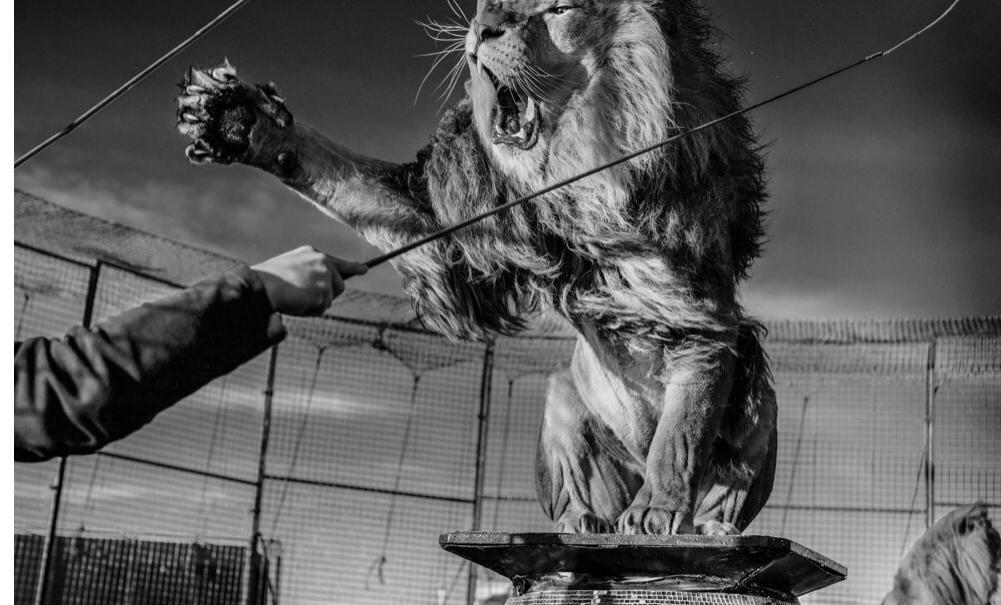
Britain’s last lion tamer, Thomas Chipperfield. Photo: Matilda Temperley
Louise Haven’t you photographed a lion tamer?
Matilda Thomas Chipperfield, eighth generation lion tamer. The last of his kind in the UK, now lions in the circus are outlawed in the UK he’s been fighting to carry on with his lions. I first photographed him for my first commission and then I went back and photographed him about seven years later. I phoned him up and I said ‘Hey Thomas, where are you and can I come and photograph you?’ It was New Year’s Day and he said: ‘I’m in Aberdeenshire and it’s snowing.’ That was a 14-hour drive away. So I said, ‘I’ll be there tomorrow.’
I jumped in my car and I went up and it was bleak and his lions were in the snow and I took, I think, some of my favourite pictures ever of Thomas and his lions. They didn’t like me very much, if you ever turned your back on them they’d sort of leap from nowhere, and it was just a really interesting thing because it was such an interesting story being the last in the line. I followed his career avidly.
Louise You’ve spent many years photographing the semi-nomadic people in the Omo River region of southwest Ethiopia.
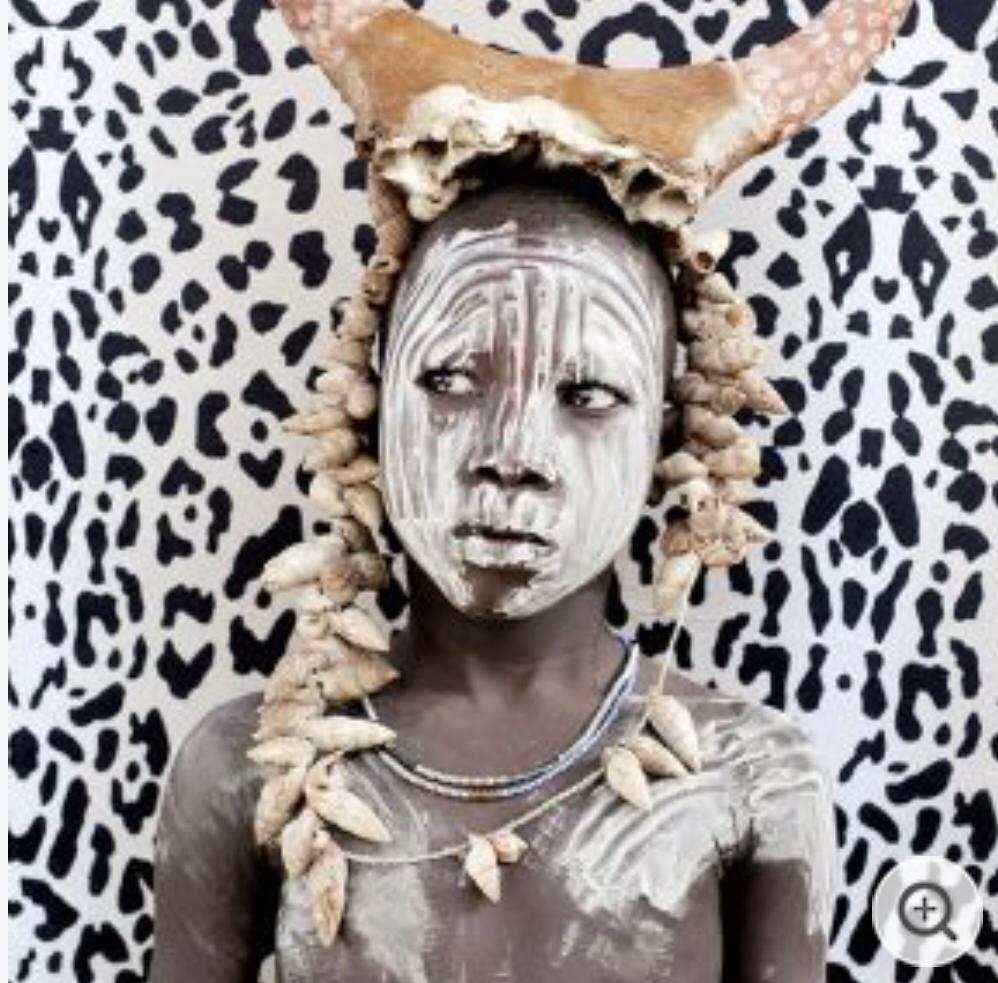
African boy. Photo: © Matilda Temperly
Matilda There’s a number of different ethnic groups down there, and it’s probably around half a million people are directly impacted by these sort of rapid changes down there. There’s lots of multifaceted changes. When I first started going there…it took me five days to get down there. Now you can drive, the roads all tarmac-ed, within a day or a day’s long drive. And so they’ve had huge problems. The national parks have been turned into multinational farms, the river flow has been stopped, there’s a huge influx of tourism, which is not very culturally-sensitive tourism.
So you’ve got a huge range of peoples that are having their livelihoods forcibly removed from them. Their culture is being squashed and it’s been a miserable time for them. I was hoping that there would be some light at the end of the tunnel, but actually, it’s such an incredible place and it has been sort of decimated by this globalisation…
….Travelling in Ethiopia was brilliant and totally different at the very beginning when I first went down there. I have a great friend who’s from there. We would get the car stuck and we’d be digging in the mud for days and camping anywhere. We’d sometimes be turned away because it was too dangerous. I took my mum there a few times and once I couldn’t find her. She was being held down by five bare-breasted ladies who wouldn’t release her until I bought them a beer.
Louise Who’s your favourite travelling companion?
Matilda My favourite travelling companion ever is my mother, especially in Ethiopia, because, one, she’s obsessed by mud house – she builds them herself. And because it really changes their attitude when you’re with someone that’s older, she’s got really long grey hair down to her waist and people always want to touch her hair. She brings a very calm attitude to it.
<<<<>>>>
Open Water Swimming With Simon Murie
Felice We explored the fun of open water swimming with Simon Murie. It’s a simple sport, all you really need as a pair of speedos or a bikini, goggles, a hat, and the ability to swim a few kilometres in the warm waters of the Mediterranean or the Caribbean, or perhaps a rather chilly North Atlantic Ocean.
Simon I think the first significant swim that got my interest was the Hellespont in Turkey, which was made famous by Lord Byron swimming across it. He actually swam in honour of Leander, who in Greek mythology would swim across the Hellespont with lover, Hero. Hero was on the European side at the castle of Sestos and she would hold out a torch. Then Leander, who was on the Asian side in the castle of Abydos, would swim across. She would hold out the torch, they would do their thing, and then later that night he would swim back. And then one night, a storm blew and Hero’s torch was extinguished and Leander lost his way and was drowned. His body washed up under Sestos Castle and Hero, seeing his body, threw herself off the castle and died alongside Leander. And that was the tragic Greek love story of Hero and Leander.

Lycian Way. Photo: © SwimTrek
Byron re-created that swim and, with a Lieutenant Colonel Ekenhead, was the first person to swim the Hellespont. And I remember reading a poem that Byron wrote. I was a mining engineer at the time in northern Nigeria on the border with Niger. I remember reading it as a schoolboy, but then I remember being up in this mine a long way from any water and thinking, ‘What is my passion in life? What do I really enjoy doing?’ And I remember I loved open water swimming, and I always enjoyed finding the most bizarre places to swim. I remember re-reading that poem from Byron and thinking, ‘You know what, when I turn 30 that’s what I’m going to do.’
So when I did turn 30, that’s what I did. I went over to northwestern Turkey and went to the town of Çanakkale and I managed to find a pilot and get various permissions. I needed a military permission, because the Hellespont is also known as the Dardanelles – the famous military campaign of World War I, and it’s straight across from Gallipoli. I needed military permission from the army, but also the navy, and also permission from the coast guard and the town council.
It took me a week to get the permission and find the pilot and about just over an hour to swim it. So that total imbalance of time with the hassle and everything made me think, ‘Well, there must be other people out there who also want to do these fantastic swims around the world, but don’t want to do all the admin, don’t want to do all the organisation and safety support.’ And that was also when my love of open water swimming blossomed, but also the idea behind what I do today which is SwimTrek – which is taking people out on these fantastic swims. So that’s where the idea came from….
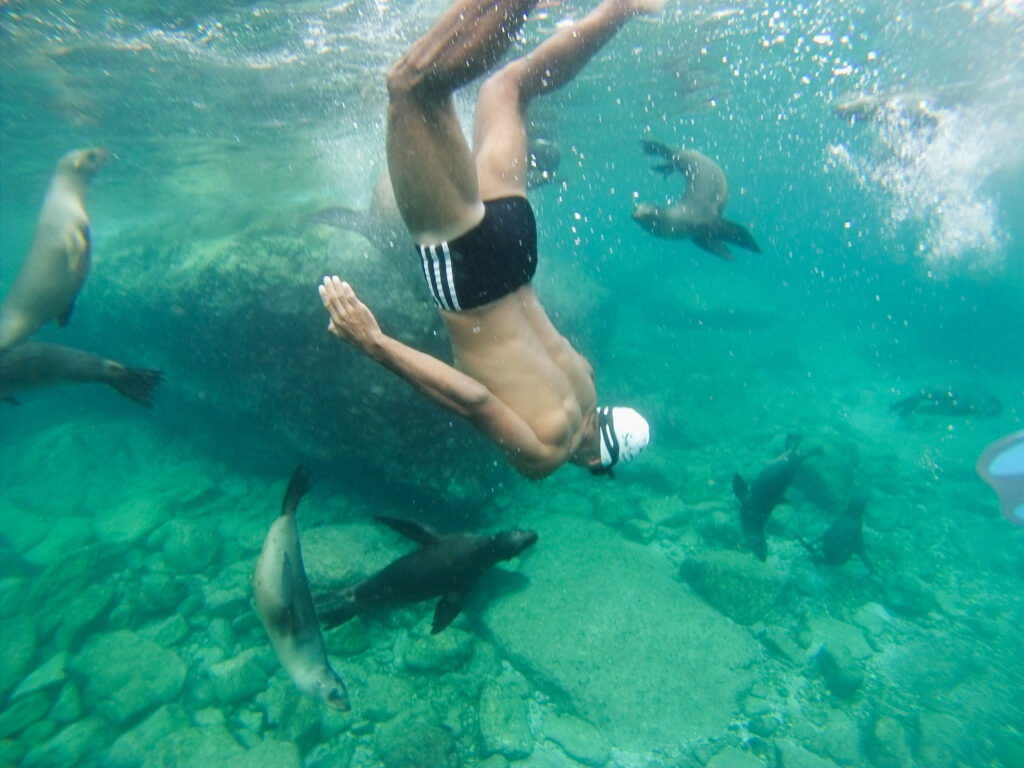
Mexican seals. Photo: © SwimTrek
… I was passionate about going to places and discovering them by swimming. I think what I loved also was this idea of arriving at a landmass under your own steam, and looking back and seeing where you’ve arrived from, so to speak. I think arriving somewhere – and you’ve powered yourself there – makes you appreciate somewhere in a way to somebody, say, who’s arrived by ferry or by boat can’t possibly do.
It’s similar to, say, hiking up Snowdon. Those who’ve hiked up Snowdon and those who’ve arrived on the train, I think appreciate the summit in two totally different ways. I think the same is when you swim from island to island, you’ve immersed yourself in the medium of getting there. I think you appreciate where you’ve arrived so much more than if you got there by plane or by ferry. And that’s where I get my pleasure out of…
Felice How fit would you have to be to do something like this?
Simon Well, it all depends, really, on the geography of where you are. We started off in the Greek Cyclades, the distance roughly between the islands there…that’s six islands and we island-hop, instead of getting the ferry, we swim. So our strap line at the time was: ‘Ferries are for wimps, let’s swim.’ And that gets the picture across of what we’re doing. But some of the crossings were two to three kilometres and some of the crossings were about 800 metres.
But there will be other places in the Med, in the Caribbean, where the distances are a lot smaller. So they would be more introductory swims, maybe anything between half a kilometre to a kilometre between islands, which is very accessible for a lot of swimmers. Then other islands are much more challenging, like in the British Virgin Islands, where maybe the average distance we’re looking at is three to four kilometres per swim…
Peter And as many women as men?
Simon Yes, I’d say slightly more women than men. Women can achieve at open water swimming just as well as men can. For example, some of the long distance records which are out there have been set by women. So it’s an activity, a pursuit that women are on an equal footing that men are, which is great. Also age-wise, it’s a low impact sport. You think of running, for example, swimming is low impact – the water absorbs a lot of the impact, so actually it’s an activity go on into the late 70s, 80s….

Lakes of Lithuania. Photo: © SwimTrek
Felice You mentioned the Virgin Islands – there must be a danger with sharks and other things in the water?
Simon Yes, I’d say for example, we swim in the Galapagos Islands where we are literally looking for sharks and understanding them and working with the National Park Service on where the sharks are, what their patterns are, and helping us understand them as well. So I would say, touch wood, there’ve never been any issues at all. I think it’s understanding them, and actually in a few locations going to find them and interact with them because they’re incredible creatures.
I think what’s more concerning on our trips is other boat traffic, and that’s why we have our own safety support going alongside them. So it’s actually the manmade stuff that we have to watch out for more, other the boat traffic in the water, and that’s why we always get local permissions but also liaise with other mariners. Actually talking about the Virgin Islands, that swim there from the British Virgin Islands to the US Virgin Islands is great; it’s actually swimming for a reason.
Now, we talked about the Hellespont where you swim for mythological reasons because of Hero and Leander, literary reasons because of Byron, and geographic reasons because you’re actually swimming from Asia to Europe. And all of those reasons are for me the things that make me want to do these swims. So for the Virgin Islands, you’re swimming from British Virgin Islands to the US Virgin Islands…so saying you’ve just come from Britain to America for me is a wonderful way and a reason to get up and actually go and do the swim…
<<<<>>>>
Geraldine Fasnacht, On A Wing And A Prayer
Peter From water to air, albeit on a wing and a prayer. Verbier base jumper, Geraldine Fasnacht’s idea of a little light, adrenaline-fuelled recreation is to climb one of Europe’s highest peaks and then dive off it in a wing suit. I started by asking her just what base jumping involves.
Geraldine Base jumping, is this starting from a fixed object. So when you jump off a building, antenna, or earth – in Switzerland we are full of mountains, so most of the objects I’m jumping off are from earth, from mountains.
Felice So how do you learn base jumping?
Geraldine To learn base jumping, I would say the best way is to have a solid experience in skydiving or also flying into a wind tunnel. Now wind tunnels are all around the world, you can fly into a tube indoors, and this is also a really good way to learn how to fly with your buddy. Base jumping is so quick, everything has to be perfect, so you cannot learn how to jump when you base jump….
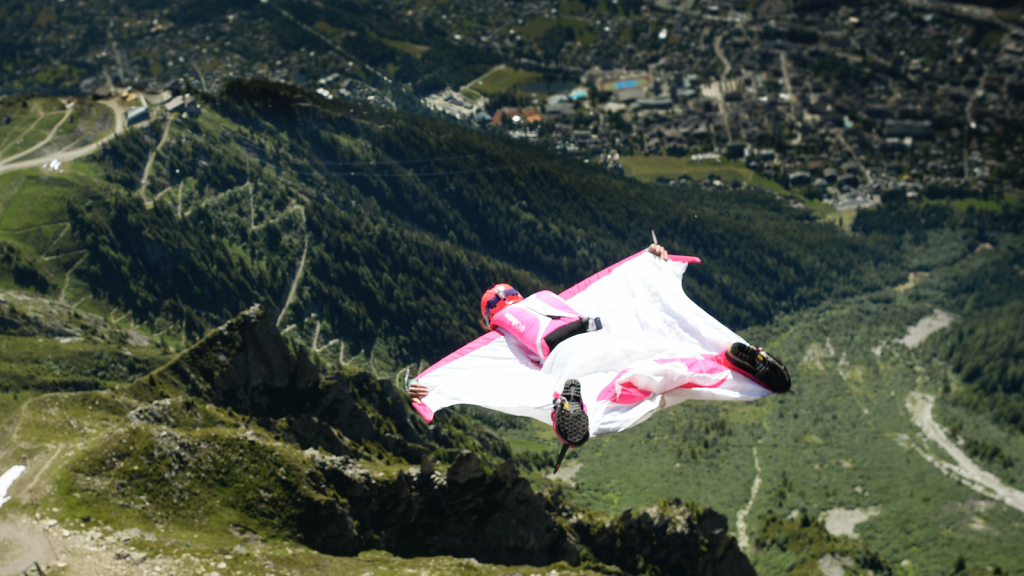
Felice And when you’re base jumping, do you have a parachute?
Geraldine Yes, you are wearing a parachute on your back and then it depends which object you are jumping off. You have sometimes really short, sometimes longer jumps. Then you can add a wing suit on your body and then you can fly longer. And it’s the same from a plane – you can jump with or without wing suits.
Peter Well, I was just going to say about wing suits, because that’s something that you now do a lot of. How do you learn to wing suit? Because there’s no room for error, no room at all. How do possibly do that first jump?
Geraldine You have to jump first from the plane one day. So it’s also a good experience from skydiving. We are actually now having some rules – for small wing suits you have to have 150 jumps without the suit. Then you can fly the small wing suits that are kind of easy to fly and you can have troubles and it’s not a big trouble to handle. And then to fly the big wing suits, you will have to have at least 250 skydives before you can fly with the big wing suits. And now there is a wing suit tunnel indoors in Stockholm, so it’s also possible to fly indoors, really safe with an instructor next to you. So this is also a really good way to learn how to to wing suit.
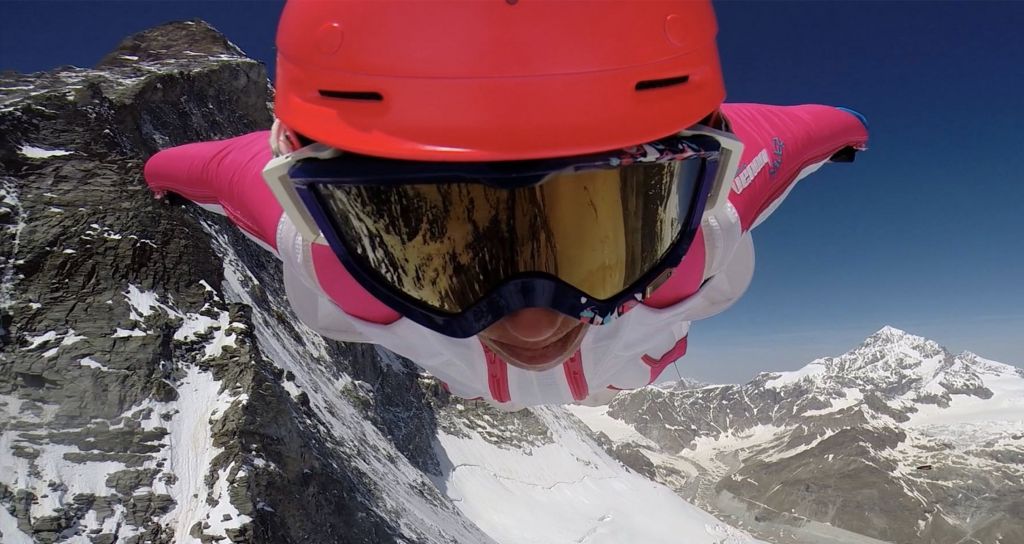
Opening off the Matterhorn
Peter And how fast, how many kilometres an hour do you go when you’re in a wing suit? What’s the fastest you travel at?
Geraldine So now there is a lot of different types of wing suits, but the wing suits I really like is called the Aura. And the Aura is flying fast for 160 kilometres per hour and it’s going down approximately at 40 kilometres an hour, vertically. But if I really go deep and I push my head down, I can go steeper and faster to 180 kilometres per hour and then I can slow down my flight before I pull my parachute. This is exactly what I do. I gain some speed, then I break. And when I break, I’m nearly not falling at all.
Sometimes if the conditions are really good, I can also go a little bit higher and not fall at all. And then I pull my parachute because now the wing suits are getting so much pressure into the wings that if you don’t dive and top your flights and lose the pressure into your wings, it’s really hard to get to your handle to open your parachute. So this is also things that we have to adapt with the new generation of the wing suits.
Peter I believe you’ve jumped off the Matterhorn.
Geraldine Yes, I did open the summit of the Matterhorn in 2014, and it was repeated several times after I opened it. And I also went back last summer for my fifth jump off the Matterhorn with my husband, because my husband haven’t done it and he was dreaming about jumping it. So I brought him there.
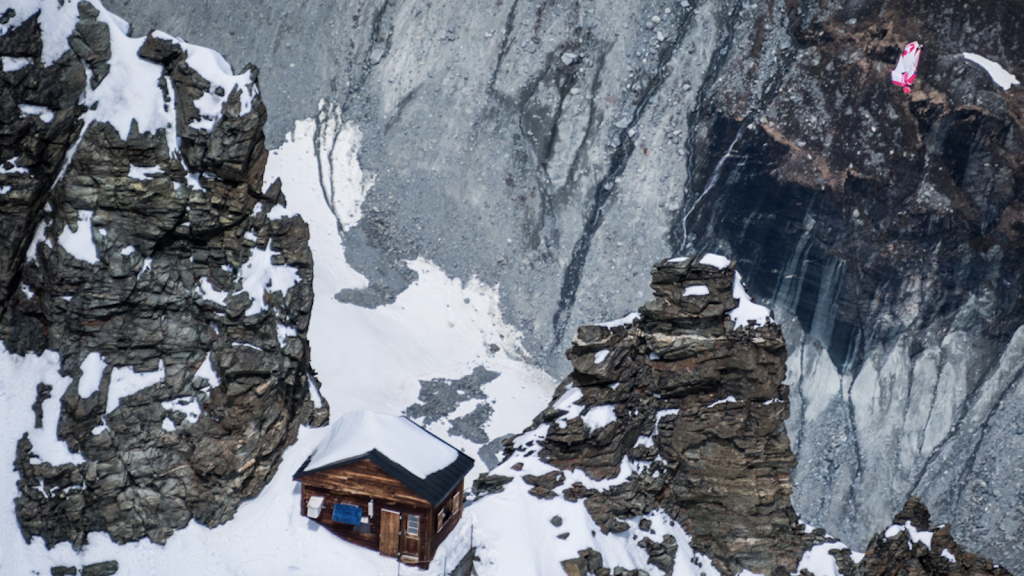
Flying off the Matterhorn. Photo: © David Carling
Felice So does your husband do the same as you do?
Geraldine Yes, unfortunately my husband is also a base jumper, but it’s also a way for us to share such incredible moments in the mountains, in the air. And we are flying together since, I would say, over 12 years now. And he’s got to a really, really big level and I really trust him 100 percent. He’s really a good flyer.
Peter Now, are you ever frightened?
Geraldine Yes, for sure. In the mountains, if you’re not frightened, it’s not good, I think, it’s always good to think twice. That doesn’t mean that I don’t make mistakes. It’s also really important to learn from your mistakes and the mistakes of the people around you, and listen to the stories of what’s happening also understand how to react differently if something happened, and train hard to have always a good reaction when the moment needs to have a good reaction, because when you’re base jumping you need to have the perfect reaction in the next second….
Felice Do you need to be very fit to do base jumping?
Geraldine Oh, yes, you need to be really fit to be base jumping because you fly with your body, so you have to really feel your body really well. If you are not fitting well into your wing suit, because you also have to put your material inside and you don’t feel like flying. Well, I can talk about myself: after my pregnancy, for example, or when I was pregnant, I was still jumping for a while and when I started to feel too fat, I was not feeling good to fly anymore, and just wanted to relax and enjoy my pregnancy and the arrival of my baby. And after the pregnancy, it took me a while to be fit again and to be ready to go jumping.
Peter Well, that’s a different take on the whole thing, Felice. I remember when you were pregnant with all three of our children, you skied and people thought that was pretty brave, but to be base jumping that’s another world altogether.
Geraldine My doctor told me that I have to do what makes me happy. And what makes me happy is to be in the mountains – and my way to be in the mountains is snowboarding and base jumping. But I stopped paragliding.
Felice Your child, how old is he?
Geraldine He is 14 months now and he’s walking, he’s a happy boy and he loves being outside.
Peter Ready for his first wing suit, no doubt!
Geraldine Not yet! He jumped enough in my belly already.
<<<<>>>>
The Amazing Giraffe Manor In Kenya
Felice Giraffe Manor has been dubbed the most Instagrammed hotel in the world, and we can see why. At first, it looks like a classic English country hotel, a mellow brick 1930s house with ivy clad walls set in landscaped gardens at the heart of 140 acres of rolling countryside. But once you’re away from the manicured lawns, you might be forgiven for guessing that the trees and general terrain are not actually in the Cotswolds, but in the outskirts of Nairobi.
And wait, what’s that poking its head through my window? A giraffe? Am I dreaming at certain times of day? Giraffes are everywhere, with heads popping up on balconies and at the breakfast table helping themselves to your toast and cornflakes? I’ve travelled a lot over the years, but for me, Giraffe Manor is one of the loveliest memories, even more so than going on a safari where you don’t actually get to touch any of the animals for obvious reasons. Giraffes are so gorgeous with their long eyelashes and beautiful colouring. They have blue tongues too. Did you know that?
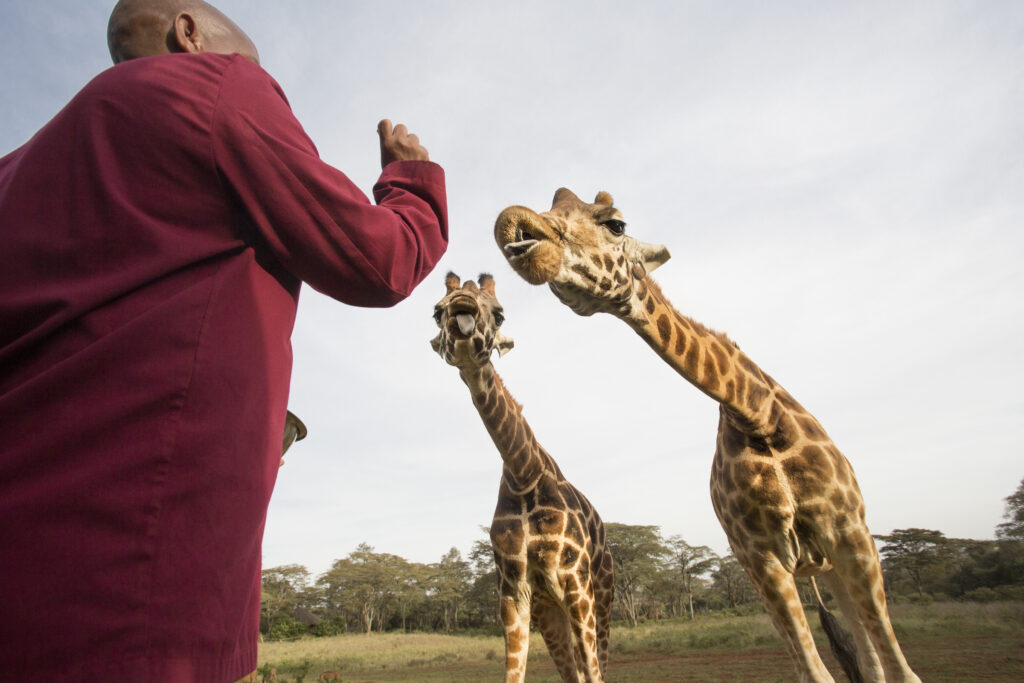
Feeding time at Giraffe Manor
We met up with Tony Levy, assistant general manager at Giraffe Manor, after eight years here? There isn’t much he doesn’t know about these delightful creatures.
Tony Did you get a kiss when you were here?
Felice I did. I got licked and I fed them by hand. So can you tell us a bit about giraffes to start with? Do you know how tall are they roughly?
Tony Ed, who’s the tallest giraffe, we reckon he is about 15 and a half, 16 feet tall, but he’s the dominant male and he’s about 10 1/2 years old.
Felice Wow. And what do they eat mainly?
Tony Out of the 140 acres that we have here, they eat all the foliage apart from – it’s known as the trumpet flower, I don’t know what the biological name is, but that’s because that’s hallucinogenic – but everything else in the compound they will eat. And the only reason why they come to us is because we feed them pellets. The pellets are corn, bran and molasses….so those tiny things that you get when you are here for breakfast. That’s the only reason why they come to us. But there has to be a bit of a respect balance with that, because it all depends on how you face them. You know, you can get an occasional ‘Good morning, you know, you’re supposed to feed me.’
Peter How many giraffes do you have in all on site?
Tony So currently on site we have 12 giraffe. So we have Ed, the dominant male; we’ve got Betty who’s our matriarch, she’s about 21 years old or going on 21; we have Kelly who is the one who is notoriously known as the head butter. She’s named after Grace Kelly; she’s about 19 going on 20. Then we do have other females. We’ve got Daisy, Salma, Stacey, we’ve got Ed. I think Salma is older than Ed because she’s about 11 years old, because all five calfs in place, so 12 on site.
Peter How do you tell a difference? Can you can you recognise them all?

Eye of the giraffe. Photo: Giraffe Manor
Tony Yes. So I’ve been here for eight years so I can tell different coats, different personalities. The ones that are a bit tricky for me right now would be the calfs, because the calfs are varying for between maybe four months to about slightly over a year, but they’re all over six feet tall. So just different coats. The coats are like our fingerprint, so every giraffe has a different coat and the characteristics is what makes them more noticeable….
Felice Can you tell us a bit about Giraffe Manor? When did it become a sanctuary for giraffes?
Tony So basically, the whole programme was started by a lady called Betty Meldrum – her and her husband, Jock Meldrum. They bought the property in the early ’70s when they bought the property there was giraffe that used to come and eat the ficus, which is what grows on the side of the building of the main manor. Betty Meldrum did fall in love with the giraffes and when she looked at the different types of giraffe that we have on site, or in Kenya, she found the Rothschild’s were critically endangered. It was literally less than 100 of those in the whole of Kenya. So that’s why she started the whole The African Fund for Endangered Wildlife in 1974, which is a giraffe conservation and breeding centre.
I think mid-80s is when they made the house an exclusive hotel. So the first giraffe brought here was named Daisy. We have a room named after her right now and so we now have Daisy the fourth, who is also a head butter giraffe, in between there was Daisy the second and Daisy the third. We also had a giraffe brought to us, Marlon. He was named after Marlon Brando who was a very good friend of the Anderson family, which is Jock and Betty Melville’s family.
Felice When was the house originally built?
Tony The house originally built in 1932 by a gentleman called Sir David Duncan and he had something to do with the Macintosh family, which is the whole toffee industry. He built it for his wife reputably, apparently, because this was the year they were in Scotland. Just before independence, he did sell the property, and moved to South Africa. So the house was abandoned. Then it was bought by, I think a few people in between never really lived inside it. And then in 1974, early ’70s, Betty and Jock, did buy it.
Felice The house looks a little bit like it might be in England…
Tony It’s a Scottish hunting house. Yes, it’s more like a Cotswold manor house, but it’s a Scottish hunting house, yes….
Felice Giraffe Manor became a hotel. When did that happen?
Tony The hotel was started in the early ’80s by the Anderson family, which is basically Jock’s family. It was a private hotel in 2009. It was sold and it was actually then bought for The Safari Collection. So the Safari Collection then made it a commercial hotel. And now we’ve expanded from initially, I think, five rooms, six rooms now to a total of 12 altogether. So it’s a very small boutique hotel, but it’s divided into two manors. We’ve got the original one from 1932 and they’ve got a new addition added, known as the Garden Manor, which is built just up to 2010.
Peter And how do the guests interact with the giraffes? I gather from pictures that they actually look through the windows, put their heads through the windows upstairs, is that right?
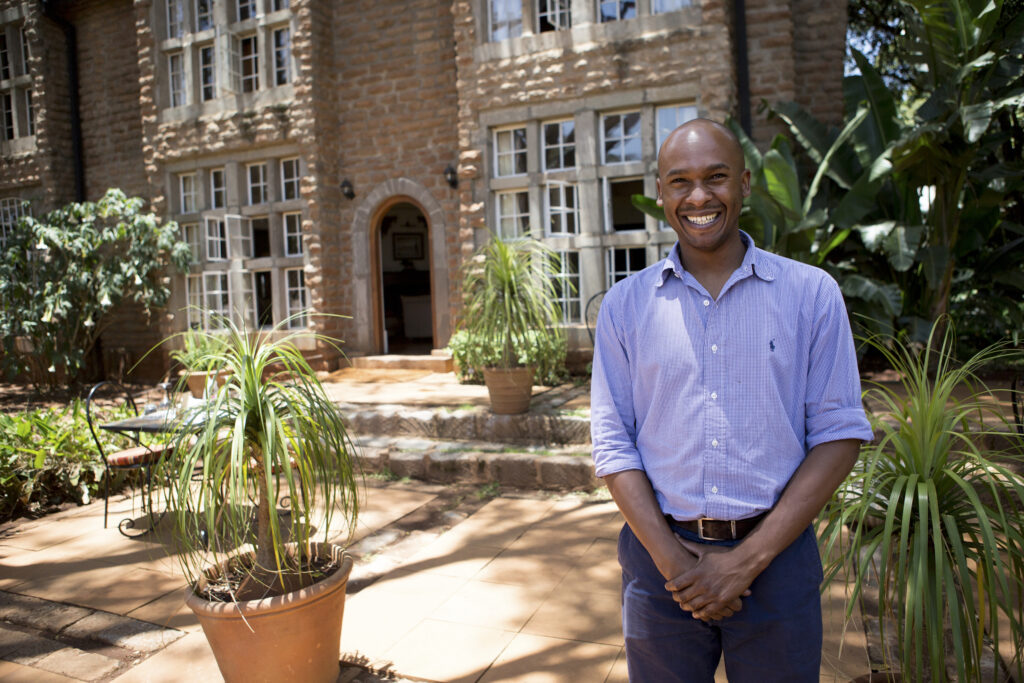
Tony, General Manager at Giraffe Manor
Tony That’s correct. So we do have two feeding programmes, two feeding times for giraffe. One of the most important is the five o’clock, which is where we have access for the guests outside the building with a small wall that separates the giraffe and the client. What happens is you can take all your pictures; you can get all your kisses. We’ve got a swing; we’ve got a famous swing on Instagram right now. So, yes, we got the High Tea Experience, which is at five o’clock, and we basically walk out the giraffe and go to the wall, you can get to feed the giraffe, the same giraffe. You can get to the side, you can get your giraffe kisses, you get the swing, which is very famous on Instagram. Everyone likes to get giraffe pictures on the swing, but the second experience and the five o’clock experience is between five o’clock until about 6pm, 6.15pm.
The most important experience will be the Breakfast Experience, and that starts any time from 6:00 in the morning to about eight in the morning, and those giraffe will have access around the building. So from your room – some of the rooms have giraffe access – you literally just crack your window open or just walk onto your verandah and you can get to feed them. The rooms have our pellets and you just give them one at the time. Come down not too long after that and you’re coming to the different breakfast rooms – one in the garden, one in the main manor. We open the windows, they put their heads right inside. And there’s lots of pretend pictures of…you’ve got people with coffee cups, but never do you really have real coffee to drink. It’s a lot of saliva I don’t think it would be quite tasty. Then eventually you do have your breakfast.
Felice Oh, it’s a wonderful experience. And they’re really gentle creatures, too.
Tony Yes, they are. It’s one of those things you have to experience yourself. No videos or pictures can do justice to what happens at Giraffe Manor.
<<<<>>>>
Legendary Explorer, John Blashford-Snell
Peter Legendary explorer Colonel John Blashford-Snell is never happier than when he finds himself astride an elephant in India while wearing a Victorian pith helmet or paddling a dugout canoe in the South American rainforest, or indeed shooting rapids in the crocodile-infested waters of the Nile. His stories are legion, and he has one of the best of them during his military career and beyond. He spent rather more than 60 years mounting scientific expeditions all over the world and encouraging young people to reach out for new horizons. In 1968, he organised an expedition with army cadets to navigate the Blue Nile, and he met one of the most intriguing figures of the 20th century/ His Imperial Majesty Haile Selassie.
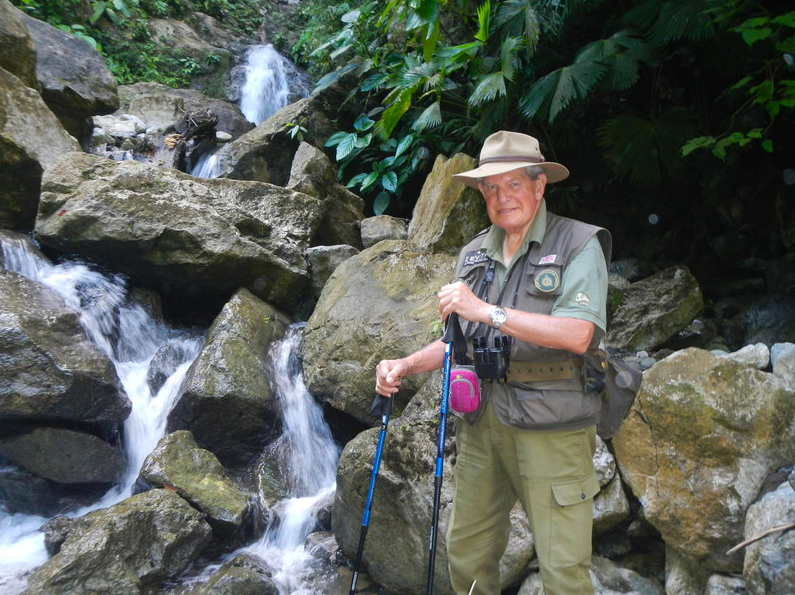
Colonel John Blashford-Snell
JBS His Imperial Majesty, Haile Selassie. He was a remarkable man. Very luckily, my godfather had known him and had helped to look after him when he was exiled to Britain during the war. So when I was looking for some really exciting place where not many people had been, my godfather wrote to Haile Selassie and asked if I could come to his country and do something useful. Amazingly, the reply came back. ‘Just send your godson out here with these cadets. We will do our utmost to provide a good task.’
The Natural History Museum in London were very eager to get specimens of various creatures ranging from bats, beetles, quite large animals – in particular a Nile crocodile and one or two other things. So we formed up these conditions that went out. And on the very last one, Haile Selassie had us all to an audience, and that was quite remarkable because I said to the minister of court, ‘When you go to meet an Emperor, what is the protocol?’
And he said, ‘Well, it’s quite simple. When you enter the throne room and there’s a 50-yard red carpet and you must walk singly up the red carpet and you bow three times as you go up – once at the door, once halfway up the carpet, finally just in front of the throne – at which point His Imperial Majesty may shake hands with you and will probably speak to you in French. Then when you come to leave the presence of so great a person, you’re required to walk backwards. You must never turn your back on him. So you walk backwards down the carpet bowing three times in reverse.’
I thought, ‘Well, that’s not too difficult, with well-drilled cadets.’ And he said, ‘Yes, there are one or two hazards you’ve got to watch out for.’
I discovered that Haile Selassie was an animal lover and in the throne room he kept an ever-shifting population of lions. So the chances of tripping over a ruddy lion and getting eaten for your pains, was really quite high. We got to the throne room with all 60 cadets, and one by one we marched in fine. But I was very lucky because I asked the Minister of the Court how we were to avoid the lions. He said, ‘Well, it’s quite simple. When you bow to the Emperor, you must cast yourselves down low and you press your forehead upon the carpet.’
I said ‘Hey, steady, we’re British. We don’t normally do that sort of thing. I mean, a simple bow is usually all that’s required.’ He said, ‘Oh no, I’m not suggesting you be obsequious, but if you look between your legs when you’re bowing, you will see the lions that are lurking behind you.’ So all 60 cadets got in and out without incident and in fact, it even led later on to taking the lions out in the marketplace – but that is another story.
As I came to shake hands with him at the end and say goodbye, he said, ‘I do hope you’ll come back and do more work in my country.’ I said, ‘What would you like us to do?’ And he said, ‘I’d like you to explore my Blue Nile.’ Well, that was rather like asking an average hill walker to climb Everest, I’d seen the Blue Nile, looking down on it from a bridge, I didn’t really think one could take on a challenge like that lightheartedly. But I muttered something, hoping it sounded polite, and bowed my way out.
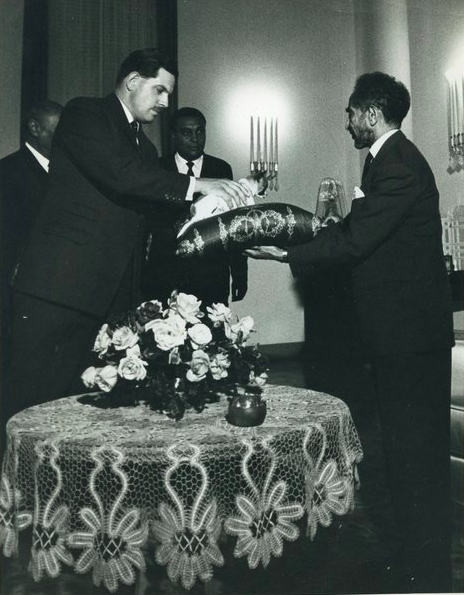
Presenting Emperor Haille Selassie with a chihuahua 1968 – Ethiopia
I returned to England and a little time later a letter reached the government from Haile Selassie saying he wanted his Blue Nile explored. It had not been fully explored at that point, and in fact, no one had really survived going through it. It was a mile-deep gorge full of crocodiles and everything else. He pointed out that he’d spoken to me about it and indicated that on behalf of the government, I’d accepted to do it, which wasn’t quite true. I was summoned by my General, who was a rather splendid sort of prickly little man, a nice chap, but he wasn’t one you argue with.
He said, ‘We’ve had a letter from His Imperial Majesty, the King of Kings, one of the Tribe of Judah, and also, by the way, a Field Marshal in the British army. He wants his Blue Nile explored and I gather you think you can do it.’ I said, ‘Well, sir, it’s not quite that. First of all, it is full of hippos, there are lots of very, very dangerous crocodiles, bandits galore, and the gorge through which it runs is a mile deep and is subject to landslides containing radioactive gas.’
He looked me in the eye and he said, ‘You’re being very negative. I don’t like negative officers. I looked into this and I think it’s just the sort of thing we need for the morale of the army and it would be a good thing to do it. We’ll get it in the papers.’ ‘Yes, sir.’ ‘Right,’ he said. ‘We’ll have a committee to run it. I shall be chairman and you will be secretary. I see no need for anyone else.’ So the Blue Nile Expedition was born.
<<<<>>>>
Felice That’s all for now. If you’ve enjoyed the show, please share this episode with at least one other person! Do also subscribe on Spotify, i-Tunes or any of the many podcast providers – where you can give us a rating. You can subscribe on Spotify, Apple Podcasts or any of the many podcast platforms. You can also find us on Twitter, Facebook and Instagram. We’d love you to sign up for our regular emails to [email protected].
© ActionPacked Travel
![]()
- Join over a hundred thousand podcasters already using Buzzsprout to get their message out to the world.
- Following the link lets Buzzsprout know we sent you, gets you a $20 Amazon gift card if you sign up for a paid plan, and helps support our show.


